

| Return to Index |
|
Paper 7 The Lancers QuadrillesContributed by Paul Cooper, Research Editor [Published - 28th August 2014, Last Changed - 3rd June 2024]A previous paper has discussed the First Set of Quadrilles. In this article we'll consider the other incredibly successful Quadrille Set from the Regency era, The Lancers1. There were several versions of The Lancers in circulation, we're going to learn about their origin and history during the early 19th Century. There are two main variants of The Lancers, those of John Duval and of Joseph Binns Hart. There has been debate about which version came first; my research is firmly in support of Duval's primacy. Duval's Set are made up of five separate Quadrilles, La Dorset, Lodoiska, La Native, Les Graces and Les Lanciers; they're a lovely set of dances and easily my favourite Quadrille Set. They were first published in 1817, by the early 1820s they had become one of the most popular Quadrille Sets in England, second only to the First Set.
Duval of Dublin and the Irish QuadrilleJohn Duval was at least a second generation dancing master. His father had, presumably, left France at some point in the second half of the 18th century. There is anecdotal evidence that John Duval (senior) was married in Liverpool in 17642. By 1797 Duval senior was working at the Theatre-Royal in Dublin3, a year later he was advertising his new Rooms and his availability to teach both dancing and fencing4. There was also a prominent dancing master in London in the 1780s named Mr Wall du Val, I've no reason to believe he was related to the Duvals of Dublin though there could have been a connection.
By 1807 John Duval Junior was advertising his own dancing business in Dublin, he promised
The Quadrille was a variety of French Country Dance that we've investigated in other papers, this dance had already enjoyed a rich history in Dublin by 1817. French Cotillion dances (a predecessor to the Quadrille) were published in Dublin in the 1770s (e.g. Saunders's News-Letter, 15th March 1773) and dancing masters such as Signor Callori (Saunders's News-Letter, 11th April 1778) and Mr Dempsey (Dublin Evening Post, 12th November 1782) taught them to Dubliners in the 1770s. A simplified arrangement of the Cotillion for just four dancers was taught in Dublin (and in Britain) in the 1780s, we've written more about this early form of the Quadrille elsewhere. A Fete conducted by Mr Castro in 1784 at Dublin's Rotunda promised
Duval did have family in London. One of his sisters married a London based dancing master named Mr Burghall around 1801 (Morning Chronicle, 16th January 1802). Burghall advertised that he had Several stage performers published Quadrilles in Dublin at around the same date as those published by Duval; other examples were published by Mons Simon, Mons Montague, Mons St. Pierre and Mons St. Albin, often through the successful music shop of John Willis. An 1822 advert published by Willis (Dublin Weekly Register, 6th April 1822) advertised the availability of six Quadrille sets by Simon, six by Duval, four by Montague, two by St Pierre, four by Le Feuillade and one each by St Albin, Aubrey and Murgriffe.  Figure 2. The first report of Duval's Lancers, April 22nd 1817. With Thanks to Irish Newspaper Archives (www.irishnewsarchive.com).
Figure 2. The first report of Duval's Lancers, April 22nd 1817. With Thanks to Irish Newspaper Archives (www.irishnewsarchive.com).
Duval's Second Set, 1817
John Willis advertised six sets of Duval's Quadrilles being available for sale in 1822 (Dublin Weekly Register, 6th April 1822):
Most of these Quadrilles have been forgotten today, indeed I've yet to find extant copies of most of them. Duval's second Set1 were different (see Figure 1). The earliest reference I've found to them is from April 22nd 1817 (see Figure 2); the advert in the Freeman's Journal records that
The advert issued by Willis mentions four of the individual dances that make up Duval's Lancers:
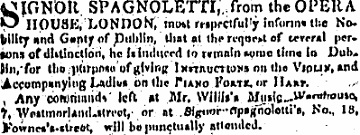 Figure 3. Spagnoletti in Dublin, December 1816. With Thanks to Irish Newspaper Archives (www.irishnewsarchive.com).
Figure 3. Spagnoletti in Dublin, December 1816. With Thanks to Irish Newspaper Archives (www.irishnewsarchive.com).
Yaniewicz, Spagnoletti and Duval were regularly mentioned in Dublin's newspapers around the year 1817. Their celebrity, combined with that of The Countess of Farnham and The Duchess of Dorset, must have helped to promote these dances locally in Ireland. They're well formed dances, the music is catchy and the figures are interesting, but the same could be said of many other Quadrille Sets, it's unclear why this specific set rose to such prominence. The Lancers happened to be published in Dublin at around the same time as the Quadrille dance form was experiencing a dramatic rise in popularity in England; perhaps the Lancers were sufficiently different from the London Quadrilles to excite interest amongst English dancers.
Les Graces, 1816The Quadrille that Willis did not name in his 1817 advert (see Figure 2) was named Les Graces. It was a popular and established Quadrille from London, perhaps of Parisian origin, that was already reasonably well known at the time. Duval didn't compose or choreograph this dance, he may have been unable to credit the composer of the music as it's the only uncredited score in the publication. Les Graces contains a particularly distinctive figure similar to The Triumph figure from Country Dancing, it was evidently a favourite with dancers.
Figure 5 shows a caricature of this distinctive figure25 published in May 1817. Three dancers are depicted, the middle most is shown turning the other two under his arms, this is the key moment in the Les Graces dance. The title The Les Graces Quadrille was also included in James Paine's 1816 3rd Set of Quadrilles, it was almost certainly danced under Paine's direction at the popular venue of Almack's Assembly Rooms. Edward Payne also included it in a later edition of his 5th Set of Quadrilles c.1817 (it replaced a Quadrille called L'Arabelle from the first two editions of his work). The Scottish writer Barclay Dun included Les Graces in his Third Set of Parisian Quadrilles in 1818 (they in turn were sourced from band leader Nathaniel Gow's c.1817 Third New Set of Quadrilles, Waltzes, & Spanish Country Dances, though Gow isn't credited). The Scottish variant uses slightly different figures to the London variant. Google Books have a facsimile of Dun's book26 but unfortunately it's missing the page that documents this dance; a transcript is available that provides the missing information27. Dun also documented a Quadrille named La Finale-Lodoiska from Edward Payne's c.1816 3rd Set, it has different figures to Duval's similarly named dance though the music is similar. The Cheltenham Chronicle for December 25th 1817 carried a report of the Berkeley Hunt Ball and Supper that featured both Les Graces and La Finale-Lodoiska, amongst many other Quadrilles to be danced28. George Shade included Les Graces in his 3rd set of Quadrilles of date unknown, they probably post-date Duval's use of the dance (Shade's 3rd Set is entirely made up of Quadrilles borrowed from the publications of Edward Payne and James Paine).
J. S. Pollock in his c.1830 La Terpsichore Moderne reported that The earliest edition of Duval's The Lancers that I've seen is a facsimile of the third edition, it's in Volume 7 of Dr. John Gardiner-Garden's Historic Dance29 series. It's effectively the same as the version in Figure 1 but can't be dated to a specific year. I'm lucky enough to own a hand written copy of Duval's Second set on paper watermarked for 1818 (but otherwise undatable), this copy is also identical to the version in Figure 1. The earliest independently datable document I've found that shows Les Graces alongside the other dances from The Lancers is a newspaper advert for Willis' A Selection of Quadrilles, Dances and Waltzes from 181830 (see Figure 6). 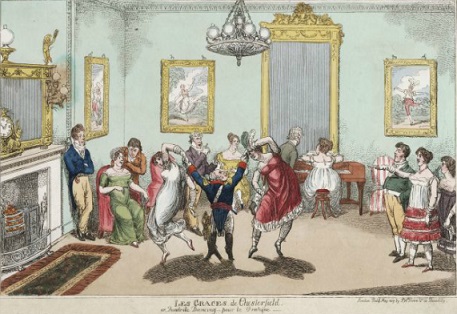 Figure 5. Les Graces de Chesterfield, May 1817. Courtesy of The Lewis Walpole Library, Yale University.
Figure 5. Les Graces de Chesterfield, May 1817. Courtesy of The Lewis Walpole Library, Yale University.
The Lancers, the Early Years, 1817-1822
The Quadrilles that form The Lancers originated in Dublin but their influence soon spread to Britain and beyond. At some point Yaniewicz began selling copies from his shop in Liverpool. His 1821 advert in the Liverpool Mercury claims that they are Incidentally, Yaniewicz's copyright only applied to the finale dance Les Lanciers; the copyright was eventually (according to a footnote in later editions of Duval's Lancers) transferred to Willis, and then to Messrs Cocks & Co32. Earlier versions of Duval's Lancers explicitly stated of Les Lanciers that theAir is published by permission of Mr. Yaniewicz. As noted above, Yaniewicz had composed the tune back in the 1790s as thePolish Rondo, it had already circulated under that name for many years before being used within The Lancers.
The success of The Lancers continued to grow. A brief report in the Freeman's Journal for 1821 notes that
Amusing anecdotes begin to surface around this time of socialites who were unaware of The Lancers. An 1821 story in The Etonian tells of a lady who was asked if she was fond of 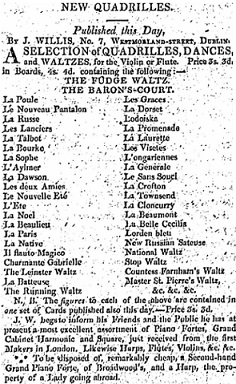 Figure 6. Willis' New Quadrilles, 1818. With Thanks to Irish Newspaper Archives (www.irishnewsarchive.com).
Figure 6. Willis' New Quadrilles, 1818. With Thanks to Irish Newspaper Archives (www.irishnewsarchive.com).
At least four other Quadrille Sets also named
A second collection was mentioned in the Morning Post newspaper for 16th October 1821, it refers to
The other new versions were the 1820 Les Lanciers of Joseph Binns Hart, and the c.1821 Original Lancers by G.M.S. Chivers. These publications are different to those of Duval but they're related; Hart's version claimed to recreate a Welsh variant of the dance
Hart's Lancers, 1819
The origin of Hart's version of the Lancers is a little unclear. Hart named his Set I've been able to compare several copies of Hart's Lanciers, including an 1820 first edition and a c.182538 4th edition. A copy of the 4th edition is available online39, though it's missing its cover; I've authenticated it through comparison to a copy at the British Library. The 4th edition are made up of La Rose, La Lodoiska, La Dorset, L'Etoile and Les Lanciers.
I don't know how Hart came to publish his version. He clearly had access to Duval's music and he knew the names of some of the dances, but the figures as published are slightly different. Perhaps Hart had a musician's hand written copy of Duval's music and wrote the figures down from memory? It's unlikely to have been plagiarism in the modern sense, popular dances and tunes were often reused (for example, consider how Les Graces came to be included in Duval's Lancers, or the story of the Country Dance Captain Wyke). I suspect that Hart either knowingly and deliberately simplified Duval's version, or the Hart subtitled his version asLes Lanciers, a second set of Quadrillesand described them as havingentirely new figures. This could imply that they are Hart's second Set of Quadrilles, but a different Set was published under that name40. So perhaps Hart was acknowledging his variant as a second version of Duval's original. As it happens, they may genuinely have been Hart's second Set of Quadrilles to be published, though I suspect they were his third or fourth such set. The 1820 Quadrille Set that eventually came to be known as Hart's Third Set was subtitledThe Hussars40 and were presumably intended to be a sequel to The Lancers. 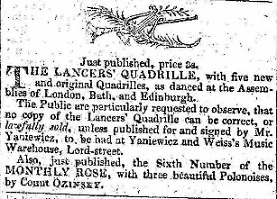 Figure 7. Yaniewicz's advert, 1821.
Figure 7. Yaniewicz's advert, 1821.Image © THE BRITISH LIBRARY BOARD. ALL RIGHTS RESERVED. Image reproduced with kind permission of The British Newspaper Archive (www.britishnewspaperarchive.co.uk) There are alterations introduced to Hart's figures between the 2nd and 4th editions of his Lanciers. The differences in the 1825 4th edition correct what appear to be mistakes in the 1st edition, later editions of Hart's publication are more similar to those of Duval's than was the first edition. The key differences are that the sequence of Hart's 4th and 5th Quadrilles are transposed (the first edition had the Les Lanciers Quadrille in 4th position and L'Etoile in 5th), and the initial figure of La Rose is taken away from the first Gentleman and given instead to the first Lady. The correction of mistakes strongly imply that Hart's Quadrilles were derived from Duval's. Yaniewicz's 1821 statement in Figure 7 is tantalisingly unclear, it's possible (though unlikely) that he was advertising Hart's version of The Lancers having licensed his copyright for the Les Lanciers music to Hart. It's notable that a W. Burton Hart was employed as a dancing master in Swansea (also in South Wales) from at least 1805 (The Cambrian, 26th October 1805); it's possible that W. Burton Hart was related to Joseph Binns Hart and that W.B. was present at the 1819 Ball in Tenby at which Hart's Lancers were reported to have been danced. W.B. may have been Joseph's immediate source of information. W. Burton Hart published a collection of Country Dances for 1812 named the Cambrian Trifles, the subtitle to this collection implied that he was very aware of the fashionable dancing at Tenby. A further Mr Hart, probably Joseph but potentially a family member, advertised his services in London as aprofessor of dancingbetween 1820 and 1822. This teacher emphasised that he taught Quadrilles - Les Lanciers(The Times, 24th December, 1822). One of the adverts hint that this teacher had the initial T., which is either a misprint or indicates that it wasn't Joseph himself. It's possible that Joseph provided the music while a relation specialised in teaching the figures to the Quadrilles.
However it came about, Joseph Hart's simplified Lanciers were published in London in 1820, they helped to fuel the interest in The Lancers. Hart himself went on to publish many more Quadrille Sets, including the Der Freyschutz (his 10th Set, in 1823); this Set was singled out by Thomas Wilson in his 1824 Danciad as being both popular and
The author of the c.1830 The Fashionable Quadrille Preceptor described Duval's Lancers as
It appears that Willis (perhaps as the copyright holder) was concerned about the rising popularity of Hart's version of the dance, he published an advert in 1826 emphasising that
The The Ventagli Quadrille Fan44, tentatively dated to 1816, contains hand written figures for the First Set on one side and for Hart's Lanciers on the other. If the Fan's 1816 date was confirmed it would represent significant new evidence, it would date Hart's Lanciers before those of Duval! I suspect the correct date of the Fan should be 1820 or later.
It's unclear which version of The Lancers was preferred by London's dancers of the 1820s, arguments can be made in favour of either variant. An 1824 review of Mr Lloyd's Quadrilles declares that they 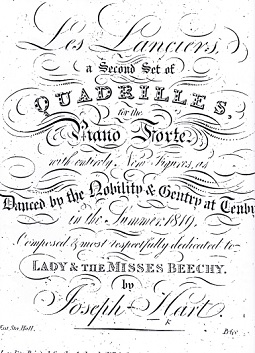 Figure 9. Hart's 1820 Les Lanciers, a Second Set of Quadrilles with entirely New Figures
Figure 9. Hart's 1820 Les Lanciers, a Second Set of Quadrilles with entirely New Figures
Image © BRITISH LIBRARY BOARD, g.270.d.(12.) ALL RIGHTS RESERVED Les Lanciers, a Mystery
A different version of the fifth Quadrille, Les Lanciers, circulated in Scotland from at least 1822. Alexander Strathy included this dance in his 1822 Elements of the Art of Dancing46. His version is related to that of Duval and Hart, with significant differences. It was also included in the Lowe brothers' 1831 third edition of their Ball Conductor and Assembly Guide, which was first published in Glasgow in 1822. Ellis Rogers in The Quadrille47 calls this a
Another interesting possibility is offered by John Gardiner-Garden in volume 7 of Historic Dance29. He makes an argument for Strathy having recorded an older version of Les Lanciers from France, and that Duval adopted this older original (much as Les Graces was adopted). Duval may have invented the name
A further possibility is that Yaniewicz supplied the name Unfortunately I'm unable to shed any further light on these issues.
With the exception of the
I've not discussed how to dance The Lancers. You can use the animations here at RegencyDances.org to help learn both Duval's and Hart's versions, or for the academically minded, I can recommend Ellis Rogers' The Quadrille47 and volume 7 of John Gardiner-Garden's Historic Dance29. 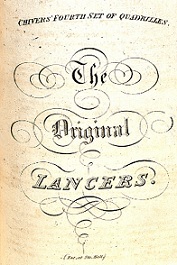 Figure 10. Chivers' 4th Set of Quadrilles, c.1821 The Original Lancers.
Figure 10. Chivers' 4th Set of Quadrilles, c.1821 The Original Lancers.
Image © BRITISH LIBRARY BOARD, 558*.c.40 ALL RIGHTS RESERVED
References1. Duval, 1817, The Lancers' Quadrilles 2. Rootschat, Dublin dancing master 1770-1800 3. Freeman's Journal, Dublin, Apr 13, 1797: An advert for the Theatre-Royal mentions a new dance by Mr Duval 4. Freeman's Journal, Dublin, Oct 04, 1798: An advert in the name of Mr. Duval, Senior 5. Freeman's Journal, Dublin, Nov 28, 1807: An advert in the name of Mr. Duval, Junior 6. Liverpool Mercury, Feb 07, 1817: An advert in the name of Mr. Duval 7. Liverpool Mercury, Mar 06, 1818: An advert in the name of Mr. Duval 8. Freeman's Journal, Dublin, Jan 30, 1818: An advert in the name of Mr. Duval 9. Freeman's Journal, Dublin, Dec 30, 1819: An advert in the name of Mr. Duval, Junior 10. Freeman's Journal, Dublin, Jan 28, 1818: An advert in the name of Mr. Duval 11. Freeman's Journal, Dublin, Dec 24, 1818: An advert in the name of Mr. Duval 12. Freeman's Journal, Dublin, Apr 22, 1817: An advert for New Quadrilles 13. Freeman's Journal, Dublin, Apr 11, 1817: Fashionable Intelligence 14. Freeman's Journal, Dublin, Jun 28, 1817: An advert in the name of Mr. Yaniewicz 15. Freeman's Journal, Dublin, Dec 31, 1816: An advert in the name of Signor Spagnoletti 16. Freeman's Journal, Dublin, Apr 13, 1822: An advert for Willis' Music Shop 17. Kreutzer, 1791, Lodoiska 18. Freeman's Journal, Dublin, Feb 01, 1816: An advert for the Theatre Royal 19. Greene, 2011, Theatre in Dublin, 1745-1820: A Calendar of Performances, Volume 6 20. Wikipedia, The Beggar's Opera 21. Gay, 1760 The Beggar's Opera 22. Liverpool Mercury, Feb 09, 1821: An advert for Yaniewicz and Weiss's Music Warehouse 23. Freeman's Journal, Dublin, Jun 28, 1817: An advert for Mr Yaniewicz's Night 24. Gerber et. al., 1824, A Dictionary of Musicians 25. Fores, 1817, Les graces de Chesterfield, or Quadrille dancing pour la pratique 26. Dun, 1818, A Translation of Nine of the Most Fashionable Quadrilles 27. Dun, 1818, A Translation of Nine of the Most Fashionable Quadrilles (transcript) 28. Cheltenham Chronicle, And Gloucestershire Advertiser, Dec 25, 1817: Home News 29. Gardiner-Garden, 2013, Historic Dance, Volume VII 30. Freeman's Journal, Dublin, May 27, 1818: An advert in the name of J. Willis 31. Liverpool Mercury, Feb 09, 1821: An advert for Yaniewicz and Weiss's Music Warehouse 32. Duval, c.1857, The Lancers' Quadrilles 33. Freeman's Journal, Dublin, Nov 29, 1821: News 34. Knight et. al, 1821, The Etonian 35. Manchester Iris, Jun 29, 1822, The Pons Asinorum 36. The Morning Chronicle, London, Apr 14, 1819: Advert for White's Quadrilles 37 The Morning Post, London, Oct 16, 1821: 'Margate' 38. Ayrton, 1825, The Harmonicon 39. Hart, 1820, Anonymous Lancers Set 40. Ayrton, 1824, The Harmonicon 41. Wilson, 1824, The Danciad 42. Wilson, 1824, The Danciad 43. Ayrton, 1826, The Harmonicon 44. Fan, Hand written instructions for Hart's Lancers 45. The Morning Post, London, Dec 14, 1824: News 46. Strathy, 1822, Elements of the Art of Dancing 47. Rogers, 2008, The Quadrille, 4th Edition 48. Durang, 1856, The Fashionable Dancer's Casket
|
Copyright © RegencyDances.org 2010-2025
All Rights Reserved